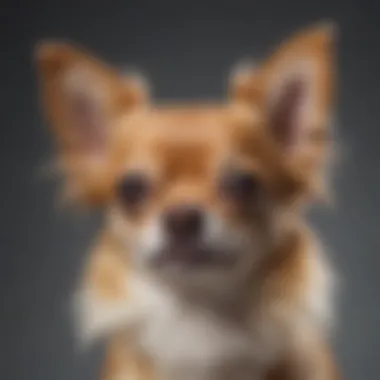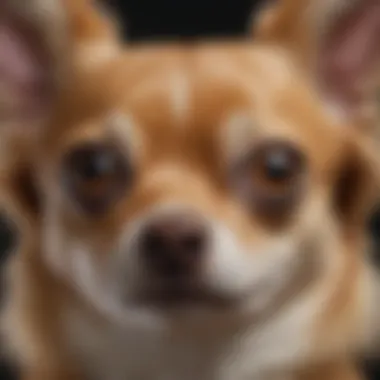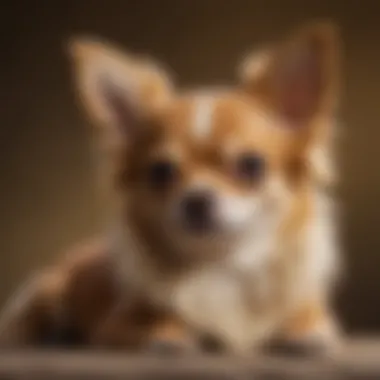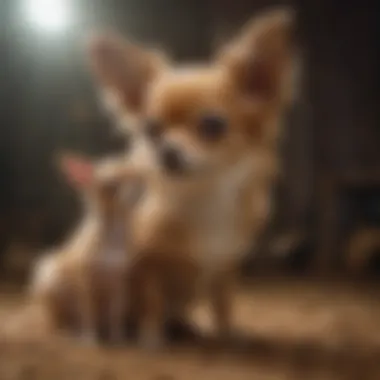The Long-Haired Deer Head Chihuahua: Care and Acquisition Guide


Intro
The long-haired deer head Chihuahua stands out as a distinct and beloved breed within canine circles. Known for their unique appearance and charming personality, these dogs have steadily gained popularity among pet enthusiasts and families. This guide delves into the essential aspects of acquiring and caring for long-haired deer head Chihuahuas, providing comprehensive information that ranges from physical characteristics to the breed's temperament and health considerations. By understanding these elements, prospective owners can make informed decisions, ensuring a harmonious relationship with their new furry companions.
Animal Overview
Common Name and Scientific Classification
The long-haired deer head Chihuahua is a popular toy breed recognized by various organizations, including the American Kennel Club. Its scientific classification is as follows:
- Kingdom: Animalia
- Phylum: Chordata
- Class: Mammalia
- Order: Carnivora
- Family: Canidae
- Genus: Canis
- Species: Canis lupus familiaris
Physical Characteristics
Long-haired deer head Chihuahuas have a distinctive appearance characterized by a slightly elongated head. They weigh usually between 4 to 6 pounds and stand about 6 to 10 inches tall. Their long, flowing coat can come in various colors and patterns, adding to their beauty.
Their ears are large and stand upright, giving them a curious and alert expression. Additionally, they possess round, bright eyes that can be expressive and can vary in color from dark brown to light amber. This breed combines elegance with a playful demeanor, appealing to dog lovers.
Habitat and Distribution
The long-haired deer head Chihuahua, although originally from Mexico, has spread internationally through responsible breeding. They adapt well to various living conditions, making them suitable for apartment living or houses with small yards. Their temperament allows them to thrive in both urban and rural settings, provided they receive adequate socialization and exercise.
Behavior and Social Structure
Communication Methods
Chihuahuas, including the long-haired variety, communicate using a range of vocalizations and body language. They might bark to express excitement, alertness, or to gain attention. Their body language—such as tail wagging, ear positioning, and posture—also conveys their feelings effectively.
Social Hierarchies
In a family or multi-pet environment, long-haired deer head Chihuahuas often develop social hierarchies. They may bond closely with their owners, seeking companionship and forming strong attachments. Proper introductions with other pets are crucial to fostering harmonious living conditions, as Chihuahuas can display possessiveness over their owners or territory.
Mating and Reproductive Behavior
Breeding long-haired deer head Chihuahuas requires careful consideration, as they can face reproductive challenges due to their size. Responsible breeders prioritize the health of both parents and the puppies, addressing genetic concerns and ensuring a suitable environment for raising the young.
Conservation Status
Current Population Trends
Currently, the population of long-haired deer head Chihuahuas is stable due to their popularity and the commitment of responsible breeders. However, like other breeds, they face challenges related to overbreeding and health issues arising from poor breeding practices.
Threats and Challenges
Some significant challenges include health problems such as dental issues and patellar luxation, common in small breeds. Furthermore, irresponsible breeding practices can lead to genetic disorders, highlighting the need for ethical breeding standards within the community.
Conservation Efforts and Success Stories
Many organizations advocate for responsible breeding practices to ensure the long-term health of the breed. Success stories often emerge from rescue groups that rehabilitate Chihuahuas and educate potential owners on the responsibilities of pet ownership, helping to secure a safe future for these dogs.
Important Note: Understand that acquiring a long-haired deer head Chihuahua requires commitment and responsibility. Ensure you are ready for the lifestyle changes and challenges that come with pet ownership.
Prologue to the Long-Haired Deer Head Chihuahua
The long-haired deer head Chihuahua is a distinctive breed that has captivated dog lovers for years. Understanding this breed is crucial for potential owners, breeders, and anyone interested in canine behavior. This is not merely a question of owning a pet; it involves a commitment to care and understanding of specific needs that set this breed apart.
This introduction serves to highlight the central aspects of the long-haired deer head Chihuahua. Not only do these dogs possess unique physical traits, but they also have specific temperament and health considerations that potential owners must be aware of. Their long, flowing coats and deer-like features make them stand out in a crowd, but beauty comes with certain responsibilities.
One key benefit of understanding this breed is the ability to foster a deeper bond between the owner and the pet. Knowledge about their character can significantly enhance training and socialization, making life easier for both the owner and the dog. Furthermore, early awareness of the breed’s common health issues can encourage preventative care, thereby improving the overall quality of life for the pet.
There are also ethical considerations surrounding the acquisition of this breed. Understanding reputable sources for getting a long-haired deer head Chihuahua can make a big difference in terms of ensuring the well-being of future pets. This section will lay the groundwork for a comprehensive exploration of various aspects of this breed, setting the stage for subsequent sections that cover physical traits, general care, and acquisition options.


Physical Characteristics
Understanding the physical characteristics of the Long-Haired Deer Head Chihuahua is paramount for prospective owners. This breed exhibits a unique blend of physical traits that not only define its appearance but also influence its needs and behavior. Recognizing these characteristics allows potential owners to provide the best care and environment for their pets.
General Size and Appearance
The Long-Haired Deer Head Chihuahua usually weighs between 4 to 6 pounds and stands about 6 to 9 inches tall. Its small size makes it an ideal companion for both city and suburban living environments. The overall appearance reflects a well-proportioned structure, featuring a deer-like profile that is both charming and distinctive.
These Chihuahuas have a slightly elongated body and a graceful neck, often giving them an elegant presence. Their eyes are large and expressive, contributing to their endearing look. It is important to consider the ratio of size to body weight, as this can affect overall health and mobility.
Distinctive Features of the Long-Haired Variety
Distinctive features are an essential part of understanding the Long-Haired Deer Head Chihuahua. The long coat is one of its most striking attributes. This coat is silky and can vary from moderately long to flowing, depending on the individual dog. The hairs are longer on the ears, tail, and neck, enhancing its appearance and creating a more regal look.
The shape of the head is another notable feature. A well-defined, rounded skull narrows into a short, pointed muzzle. This characteristic face shape influences not only the breed's visual appeal but also its respiratory functions, making a vet check-ups essential for any health concerns related to breathing.
Color Variations and Markings
The color palette of the Long-Haired Deer Head Chihuahua is diverse. Standard colors include fawn, black, white, chocolate, and cream. Additionally, these dogs can exhibit various markings and patterns, which sometimes include spots or brindle combinations.
Understanding color variations helps in identifying individual dogs and appreciating their unique beauty. Regardless of color, all variations contribute to the charm and appeal of this breed. Some owners prefer specific colors based on personal tastes or breed standards, which should always be considered when acquiring a pet.
Each unique color and characteristic further emphasizes the individuality of each Long-Haired Deer Head Chihuahua, enriching the bond between pet and owner.
Temperament and Behavior
Understanding the temperament and behavior of the long-haired deer head Chihuahua is crucial for potential owners. This breed is known for its unique personality traits, which directly affect how they interact with people and other animals. The importance of recognizing these traits cannot be overstated. Owners who grasp their pet's disposition will find it easier to establish a harmonious relationship with their Chihuahua and provide appropriate training and socialization.
Social Traits and Interaction
Long-haired deer head Chihuahuas tend to socialize well, although they can be cautious around strangers. They often bond strongly with their owners, contributing to an affectionate atmosphere within the household. Social traits of this breed include:
- Affectionate Nature: This breed is known for its loyalty. They often seek physical closeness with their people, whether snuggling on the couch or following their owners around the house.
- Alertness: These dogs are highly alert and often act as excellent watchdogs. Their tendency to bark at perceived threats can be both a benefit and a challenge, depending on the owner's environment.
- Playfulness: Long-haired deer head Chihuahuas are energetic and playful. Their playful nature can help them interact positively with well-adjusted children and other pets, provided they are introduced properly.
To foster good social traits, early socialization is crucial. Introducing your Chihuahua to different environments, people, and pets will help them become well-adjusted adults.
Training and Obedience
Training a long-haired deer head Chihuahua involves patience and understanding their unique temperament. While they are intelligent, these dogs can be stubborn. Effective training methods focus on building trust and ensuring consistency.
Key elements of successful training include:
- Positive Reinforcement: Using treats and praises encourages good behavior. A happy demeanor during training sessions usually results in a more enthusiastic learner.
- Short Sessions: Because of their short attention spans, the training sessions should be brief but engaging. This helps maintain their interest and ensures they absorb the information better.
- Focus on Commands: Basic commands like sit, stay, and come are essential for safety. Practicing these commands regularly ensures the dog understands what is expected.
In summary, understanding the temperament and behavior of long-haired deer head Chihuahuas lays the groundwork for successful ownership. By focusing on their social traits and training habits, owners can create a fulfilling environment that fosters the pet’s well-being.
Health Considerations
Understanding the health considerations relevant to the long-haired deer head Chihuahua is fundamental for any prospective owner. This breed, like any other, has its own set of health challenges and preventative measures that can significantly impact its quality of life. Recognizing and mitigating these risks ensures a happier, healthier companion. The following sections provide insight into common health issues and the necessary preventive care that should be prioritized.
Common Health Issues
Long-haired deer head Chihuahuas are generally sturdy dogs, but they can be prone to certain health issues. Awareness of these conditions helps in early detection and management. Some common health issues include:
- Dental problems: Smaller breeds are more susceptible to dental disease. Regular dental care is crucial.
- Patellar luxation: This condition involves dislocation of the kneecap, which can cause discomfort and mobility issues.
- Heart disease: Many Chihuahuas face heart problems, especially as they age.
- Obesity: Due to their small stature, weight management is critical. Obesity can lead to various health complications.
- Hypoglycemia: Low blood sugar is particularly concerning for puppies.
Addressing these issues involves regular veterinary check-ups and being vigilant for any signs of discomfort or behavioral changes. Prompt action can often prevent these problems from escalating.
Preventive Care and Vaccinations
Preventive care forms the cornerstone of maintaining a long-haired deer head Chihuahua's health. Regular vaccinations protect against infectious diseases that can be severe or even fatal. Key vaccines include:
- Canine parvovirus: Highly contagious and potentially lethal, especially in puppies.
- Distemper: This virus threatens the nervous system and is preventable through vaccination.
- Rabies: Legally required in many areas, rabies vaccination is crucial for both health and legal reasons.


Additionally, routine veterinary appointments play a vital role in preventive care. These visits often include:
- Regular physical exams to monitor overall health and detect potential issues early.
- Dental cleanings to prevent periodontal disease.
- Parasite control to protect against fleas, ticks, and worms.
Regular vet visits are essential for maintaining your pet’s health and should not be overlooked.
While caring for your long-haired deer head Chihuahua can seem overwhelming, establishing a thorough routine for preventive health care can ensure many happy years together.
Care and Maintenance
Caring for a long-haired deer head Chihuahua goes beyond basic necessities. It involves understanding the unique traits and requirements that this breed presents. Proper maintenance ensures that these animals thrive and provides a fulfilling companionship for their owners. Incorporating quality care into daily routines protects against health issues and encourages good behavior, enhancing the owner's experience.
Dietary Needs
A balanced diet is crucial for the long-haired deer head Chihuahua. These small dogs have specific nutritional needs that must be met for their overall well-being. Owners should choose high-quality dog food that lists real meat as the primary ingredient.
Key Points on Dietary Needs:
- Age Consideration: Puppies require different nutrition compared to adults. Puppy food should focus on higher protein content for growth, while adult dogs need balanced nutrients to maintain weight and health.
- Portion Control: Due to their small size, it's important to monitor portion sizes to prevent obesity. Regular consultations with a veterinarian can assist in determining the right amount of food.
- Avoid Human Food: Many human foods can be harmful to dogs. Foods that are safe for humans may be toxic to Chihuahuas.
- Hydration: Always ensure fresh water is available, especially during hot weather.
The following list contains recommended food types:
- Dry kibble formulated for small breeds
- Canned food for additional moisture
- Raw or cooked meat, with vegetables and grains as supplements
Grooming and Coat Care
The long-haired variety of the deer head Chihuahua requires consistent grooming to ensure their coat stays healthy and clean. Regular grooming also helps reduce shedding.
Important Grooming Routine Steps:
- Brushing: Brush the coat at least once a week to prevent matting. During shedding season, increase the frequency to twice a week.
- Bathing: Bathe the dog every month or as needed. Use a gentle shampoo that is formulated for dogs.
- Ear Care: Check ears regularly for debris and clean gently with a vet-recommended solution.
- Nail Trimming: Trim nails every few weeks to avoid discomfort.
Good grooming practices not only improve the dog's appearance but also promote skin health and a strong bond between the pet and owner.
Exercise Requirements
Physical activity is vital for a long-haired deer head Chihuahua to maintain health and avoid behavioral issues.
Exercise Insights:
- Daily Walks: Aim for at least 30 minutes of brisk walking split into two sessions each day.
- Playtime: Engage in interactive play. Toys like ropes or balls stimulate their curiosity and encourage exercise.
- Environment Changes: Take the dog to new places periodically. Variety in the surroundings makes exercise more enjoyable and offers mental stimulation.
Keeping an eye on energy levels and adjusting exercise routines is crucial. Tailor activities to specific needs of each dog, as some may require more or less activity than others based on age and health.
A well-exercised dog is often a well-behaved dog.
Finding a Long-Haired Deer Head Chihuahua for Sale
Acquiring a long-haired deer head Chihuahua requires careful consideration and informed decision-making. This section focuses on how to effectively find these unique dogs. Understanding where to look and what to look for will ensure that potential owners make responsible choices. It is vital to consider the source from which you are acquiring your Chihuahua, be it a reputable breeder, a pet store, or through adoption.
Reputable Breeders vs.
Pet Stores
When searching for a long-haired deer head Chihuahua, one must assess the differences between purchasing from a reputable breeder and a pet store. Breeders specializing in this breed will typically prioritize health, temperament, and adherence to breed standards. They often provide valuable information about the dog’s lineage, health clearances, and socialization. In contrast, pet stores may not always have this depth of knowledge or care in selection.
Key Considerations:
- Health: Breeders often conduct health screenings, ensuring puppies are free from genetic disorders. Pet stores may sell puppies from puppy mills where health checks are minimal.
- Socialization: Breeders usually raise puppies in a home environment, fostering better social skills. Pet store puppies might lack appropriate early social interactions.
- Lifespan Support: A good breeder offers long-term support and advice, whereas a pet store transaction is often just that—a transaction.
Visiting a breeder allows prospective owners to see the conditions in which the puppies are raised, which is often not possible with pet stores. This transparency can lead to a more confident decision.
Adoption and Rescue Options


Adopting a long-haired deer head Chihuahua offers another valuable option. Shelters and rescue groups are becoming increasingly aware of this breed’s appeal. Many Chihuahuas, including the long-haired varieties, are in need of loving homes.
Benefits of Adoption:
- Saving Lives: Adopting from a shelter or rescue gives a dog a second chance. Many dogs in these facilities have experienced neglect or abandonment.
- Lower Costs: Adoption fees are typically more affordable than purchasing from breeders or stores.
- Community Support: Many rescue organizations rebound adoptive families with resources for training and care.
When considering adoption, it is crucial to inquire about the dog’s background and health status. Most rescues provide veterinary care, ensuring that the dogs are up-to-date on vaccinations and spay/neuter procedures. A matched transition is vital for both the dog and the owner.
Ultimately, the decision on where to acquire a long-haired deer head Chihuahua should center on commitment to ethical practices and the well-being of the dog. Start by researching local breeders, checking their credentials, and visiting shelters, as both paths can lead to fulfilling relationships with these expressive companions.
Pricing and Budget Considerations
Understanding the financial implications of acquiring a long-haired deer head Chihuahua is critical for any prospective owner. Many individuals may overlook the costs associated with ownership beyond the initial purchase price. Recognizing these elements can ensure a smooth transition into pet ownership and promote responsible care practices.
Initial Purchase Cost
The initial purchase cost of a long-haired deer head Chihuahua can fluctuate based on several factors. These factors include the breeder's reputation, geographic location, and the puppy's lineage. Generally, prices may range from $500 to $2,500. While a lower price might seem appealing, it is crucial to consider the potential trade-offs such as health and temperament.
Purchasing from reputable breeders may command higher prices, but it often guarantees better breeding practices. These breeders typically provide health clearances for the puppies and their parents, reducing the risk of inherited health issues.
Moreover, when acquiring a puppy, consider additional upfront expenses:
- Vaccinations
- Initial veterinary checkup
- Microchipping fees
Budgeting for these costs at the start can prevent future financial stress.
Long-term Financial Commitment
The long-term financial commitment associated with owning a long-haired deer head Chihuahua extends far beyond the initial purchase price. It involves ongoing costs such as food, grooming, regular veterinary care, and unexpected expenses relating to health issues.
- Routine Veterinary Care: Regular check-ups and vaccinations are necessary to ensure the dog's health. Annually, expect to spend around $200 to $500 on veterinary expenses.
- Quality Food: Feeding a Chihuahua high-quality kibble is essential. Monthly food expenses could range from $30 to $75.
- Grooming Costs: This breed requires regular grooming to maintain its long coat. Depending on the grooming services accessed, this can run anywhere from $50 to $100 every few months.
- Emergency Care: It's wise to set aside funds for emergencies. Unexpected health issues could easily accumulate costs in the hundreds or thousands.
Understanding the financial aspects of pet ownership is crucial. A well-prepared owner can provide a more stable and happy environment for their pet.
Legal and Ethical Considerations
Understanding the legal and ethical aspects surrounding the long-haired deer head Chihuahua is crucial for any prospective owner. These considerations not only guide the acquisition process but also influence responsible ownership and community awareness regarding this breed. Following legal guidelines ensures compliance with breed regulations, while ethical considerations promote the welfare of the animals.
Understanding Breed Regulations
Knowledge of breed-specific regulations is paramount when adopting or purchasing a long-haired deer head Chihuahua. Many regions have laws that regulate the breeding, sale, and ownership of dogs. Key aspects include:
- Licensing Requirements: Many areas require pet owners to license their dogs. This process usually involves a fee and may require up-to-date vaccinations.
- Breed-Specific Laws: Some municipalities might have restrictions or standards for certain breeds. Awareness of these laws can prevent legal issues.
- Registration of Breeders: In many locations, reputable breeders must be registered. This ensures they follow ethical guidelines in breeding methods, thereby prioritizing the health and temperament of the puppies.
Being informed about these laws can prevent misunderstandings and promote responsible pet ownership.
Promoting Ethical Breeding Practices
Promoting ethical breeding practices is essential for ensuring the well-being of the long-haired deer head Chihuahua. Ethical breeders prioritize the health and genetics of their dogs. Important factors to consider include:
- Health Testing: Ethical breeders conduct health screenings to identify genetic disorders prevalent in the breed, such as heart murmurs and patellar luxation.
- Socialization: Dogs raised in a nurturing environment are often better adapted to family life. Ethical breeders expose their puppies to various stimuli and experiences from an early age, preparing them to be well-rounded pets.
- Commitment to Lifelong Responsibility: Reputable breeders provide lifelong support to the dog owners. They advocate for their pups to be returned if ownership becomes untenable, ensuring that dogs do not end up in shelters.
“Choosing an ethical breeder significantly impacts the quality of life for both the dog and its owner.”
By supporting ethical breeding practices, buyers can contribute to the overall health and longevity of the breed, while also promoting responsible ownership within their communities.
Epilogue
In summary, the long-haired deer head Chihuahua presents a unique blend of qualities that make it a remarkable companion for various households. Understanding the essential aspects of this breed is crucial for any prospective owner. This guide has touched on multiple important elements concerning the breed, and acknowledging these will ultimately lead to a more successful experience in dog ownership.
One key consideration is the breed's physical characteristics, such as size and coat type. These traits influence not only the dog’s general care but also how well it integrates within family dynamics. For instance, knowing the grooming needs is essential to maintain the health of its long hair and ensure comfort, as these dogs can have varying reactions to different weather conditions.
The temperament and behavior of the long-haired deer head Chihuahua are essential elements to tackle before bringing one home. These Chihuahuas can be affectionate and social but may also exhibit shyness. Thus, training and socialization from an early age is important to cultivate a well-adjusted dog that integrates well with children and other pets.
Health considerations cannot be overlooked. The breed is prone to specific health issues that can affect its longevity. Regular vet check-ups, a balanced diet, and preventive measures are crucial to ensure the dog remains healthy and happy throughout its life.
When it comes to acquisition and sourcing, being informed on the differences between reputable breeders and pet stores can guide potential owners toward making better choices. Understanding the pricing factors of these dogs helps set realistic expectations for the financial commitment. Additionally, exploring adoption options promotes responsible ownership and can help save a dog in need of a home.
Lastly, awareness of legal and ethical considerations is vital for any dog owner. From understanding breed regulations to promoting ethical breeding practices, responsible ownership takes many forms. By engaging with this comprehensive guide, readers are now equipped with insights to make informed choices about acquiring and caring for a long-haired deer head Chihuahua. By doing so, one can not only enhance their own lives but also ensure the well-being of their furry companion.







